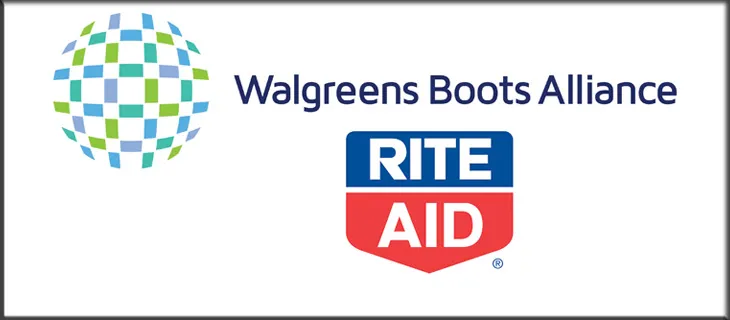NEW YORK — The impending closure of Walgreens Boots Alliance’s purchase of nearly 2,000 Rite Aid stores will clear the fog around both companies since their terminated merger deal and enable them to move ahead, Wall Street analysts say.
WBA and Rite Aid yesterday announced that the Federal Trade Commission approved a downsized agreement in which WBA will acquire 1,932 stores, three distribution centers and related inventory from Rite Aid for $4.375 billion. Also under the deal, Rite Aid gets an option to join the Walgreens Boots Alliance Development (WBAD) group purchasing organization, which would enable Rite Aid to buy generic drugs at a cost similar to that of Walgreens for 10 years.
The amended transaction, too, allows Rite Aid to hold onto 254 more stores than under the deal announced June 29 and comes almost two years after WBA’s original acquisition offer for Rite Aid on Oct. 27, 2015, which ended up being ditched because of the FTC’s lingering antitrust concerns about a Walgreens-Rite Aid merger.
Jefferies analyst Brian Tanquilut called the FTC’s green light to the latest deal “a clearing event” for WBA.
“FTC approval of the new Rite Aid asset purchase finally removes the regulatory overhang that’s clouded the [WBA] stock’s story over the last 24 months,” he wrote in a research note Tuesday. “We believe investors will now be able to refocus on WBA’s positive underlying fundamentals — preferred network Rx gains, Beauty Differentiation redesign and WBAD’s growing purchasing power — the anticipated greater than $300 million in synergies from the approved Rite Aid transaction and a robust share repurchase program ($5 billion annually).”
Plans call for the purchases of the Rite Aid stores — located mainly in the Northeast and South — to start next month and wrap up next spring, and eventually being converted to the Walgreens banner.
As a result, Walgreens will become the nation’s biggest chain drug retailer with roughly 10,100 U.S. drug stores, compared with 9,700-plus stores for No. 2 CVS Health. Rite Aid will have about 2,600 stores after the sale is completed, along with its EnvisionRx (PBM), RediClinic (retail health clinics) and Health Dialog (health coaching and analytics) businesses.
“This now gives WBA over 10,000 stores in the U.S., modestly ahead of CVS, and provides WBA the opportunity to reduce costs. We would anticipate WBA to consolidate stores over time, particularly in the Northeast,” according to Wolfe Research analyst Scott Mushkin. “With the revised asset purchase agreement outlined in June anticipated to be modestly accretive in the first full year post-close, we would anticipate the benefits of the transaction, including synergies to build over the next few years.”
Mushkin said in a research note Tuesday that he believed the store count in the Rite Aid asset sale might have been pared further. “Given the market share concentrations, we are not surprised to see a downwardly revised number of stores acquired — 1,932 from 2,186 — but are still somewhat surprised the FTC went along with the revised asset light transaction,” he wrote.
With the Rite Aid locations, Walgreens will see its market presence swell in the Northeast and South, Tanquilut noted in his report.
“Ex-potential store closures, our state-by-state analysis reveals that WBA will now be the largest drug store operator by store count in eight additional states — Alabama, Georgia, Maine, North Carolina, New York, Rhode Island, Vermont and West Virginia — bolstering their already large market share in the Northeast and Southeast, now positioning WBA as the largest operator in 32 states nationwide,” he explained.
“We do acknowledge that the new approved deal implies that Rite Aid will be retaining 228 more stores in the Mid-Atlantic region (New York, New Jersey and Connecticut) than in the previous deal’s disclosure. And we believe that the missed opportunity to add stores in these states — and their perceived better operating performance metrics — is the main reason for [Tuesday’s] underperformance in WBA shares.”
Though Rite Aid will lose nearly half of its more than 4,500 drug stores with the sale, the company will be on more solid footing, Zacks Investment Research reported.
“The transaction is likely to benefit Rite Aid in lowering debt position and improving financial leverage and balance sheet,” Zacks observed in an analysis of the agreement on Wednesday. “The company intends to use the funds from this deal to pay down a part of its huge debt. The deal will also make Rite Aid a smaller, but stronger firm with lesser exposure to the pressures of unfavorable pharmacy reimbursement rates, which has been a hindrance for the company for quite some time now.”
Walgreens will benefit from a “significant expansion” of its footprint, Zacks added. “With the approval of this long-awaited deal, Walgreens is now ready to become the No. 1 drug store chain in the United States by size, leaving behind CVS Health. Further, Rite Aid will occupy the third spot.”
WBA, Rite Aid and their traditional competitors, however, will have to grapple with a changing chain drug sector going forward, Mushkin pointed out.
“The drug store industry is seeing a more difficult operating climate. In the front end, these challenges are related to the consumer moving many purchases online, and we would anticipate that this trend is likely to continue and perhaps accelerate as both Amazon and Walmart encourage consumers to have these items delivered,” he said in his report.
Over the next few years, pharmacies will encounter two key areas of concern, Mushkin explained. “First, we would anticipate reimbursement pressures to continue and, if the economy were to ever slow this pressure could worsen, given the significant government control and the generally poor financial conditions of many government entities,” he wrote. “The second issue is our belief that Amazon is likely to enter the pharmaceutical dispensing business by 2020. Taken together, it throws into question the need for thousands and thousands of high-cost drug stores (real estate and labor) over time.”






